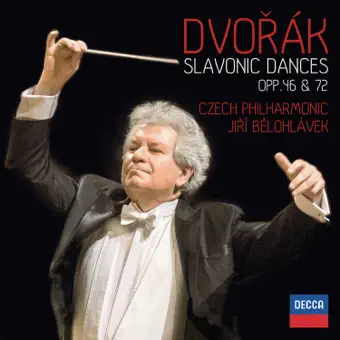december 2016
Dvořák: Slavonic Dances, Opp. 46 & 72
Czech Philharmonic Orchestra o.l.v. Jiří Bělohlávek
Er zit een rijke diepte in deze glorieus gespeelde Slavische dansen, waarbij Bělohlávek de melodieën laat zweven met een prachtig gevoel voor natuurlijk ritme.

In mijn ervaring is het vrij zeldzaam dat dirigenten die uitblinken in Dvořáks eerste set van Slavische dansen net zo effectief zijn in zijn tweede set. Rafael Kubelík van het Symfonieorkest van de Beierse Omroep vormt een zeldzame uitzondering, maar bij Jiří Bělohlávek voel ik een voorkeur voor, of op zijn minst een speciale empathie voor, de tweede set. Decca's rijk gedetailleerde Rudolfinum-opname helpt die indruk te consolideren, met zijn stevige baslijn en brede dynamische bereik.
Bělohlávek is vooral effectief in de Brahmsiaanse contouren van de tweede en achtste van de Op 72-dansen, beide met de zeer Brahmsiaanse markering grazioso. Ga bijvoorbeeld naar 3'14" in Op. 72 nr. 2 en let op de manier waarop de hogere snaren rijkelijk worden ondersteund door hun lagere tegenhangers, of de even weelderige opening van Op. 72 nr. 8, de hele uitvoering met intelligentie en genegenheid geformuleerd. Het belangrijkste (vooral hier) is de manier waarop Bělohlávek en zijn spelers het emotionele hart van de muziek overbrengen, de natuurlijke eb en vloed.
De snellere dansen werken ook, met name Op. 72 nr. 3, waar Bělohlávek zinvol wisselende tempi met echte vaardigheid onderhandelt: je voelt een verhalende inslag in het spel, een gevoel van verlangen in dezelfde dans (1'34", voornamelijk overgebracht door de houtblazers) voordat Dvořák ons op een duizelingwekkende, donderende accelerando zet. Dat verhalende aspect is het meest aangrijpend in de melancholische Op 72 nr. 4, terwijl het snellere, vrolijkere middendeel (3'01") zich ontvouwt met een innemende glimlach.
Wat betreft Op 46 biedt Bělohlávek gewichtige, doelbewuste verslagen van de snellere dansen en brengt een waarneembaar pastoraal element in de langzamere. Net als bij Op 72 markeert hij de overgangen met de hand van een echte meester wanneer de tempi binnen een enkel stuk variëren. Het enige dat echt ontbreekt in Op 46 is een beslissende mate van opwinding, een luchtige kwaliteit die Kubelík, Karelejna en Karel Ančerl (met de Vienna SO, op dit moment alleen in mono maar binnenkort opnieuw uitgebracht in stereo) bijna vanzelfsprekend aan de muziek toevoegen. Ik denk dat ik een helderdere, lichtere toets bedoel, maar in alle andere opzichten is dit een uitzonderlijke set van de Slavische dansen.

In my experience it’s fairly rare that conductors who excel in Dvořák’s first set of Slavonic Dances are quite as effective in his second set. Rafael Kubelík with the Bavarian Radio Symphony Orchestra provides a rare exception but with Jiří Bělohlávek I sense a preference for, or at least a special empathy with, the second set. Decca’s richly detailed Rudolfinum recording helps consolidate that impression, with its firm bass-line and wide dynamic range.
Bělohlávek is especially effective in the Brahmsian contours of the second and eighth of the Op 72 dances, both involving the very Brahmsian marking grazioso. Go to, say, 3'14" into Op 72 No 2 and note the way upper strings are richly supported by their lower-lying counterparts, or the similarly opulent opening of Op 72 No 8, the whole performance phrased with intelligence and affection. Most important (especially here) is the way Bělohlávek and his players convey the emotional heart of the music, its natural ebb and flow.
The faster dances work too, most notably Op 72 No 3, where Bělohlávek negotiates meaningfully shifting tempi with genuine skill: you intuit a narrative slant to the playing, a sense of yearning in the same dance (1'34", conveyed principally by the woodwinds) before Dvořák launches us on a dizzy, thunderous accelerando. That narrative aspect is at its most poignant in the melancholy Op 72 No 4, while the faster, cheerier central section (3'01") unfolds with a winning smile.
As to Op 46, Bělohlávek offers weighty, purposeful accounts of the faster dances and brings a discernible pastoral element to the slower ones. As with Op 72, whenever tempi vary within a single piece, he marks the transitions with the hand of a true master. All that is really missing in Op 46 is a clinching degree of exhilaration, a breezy quality that Kubelík, Karelejna and Karel Ančerl (with the Vienna SO, only in mono at the moment but soon to be reissued in stereo) bring to the music almost as a matter of course. A brighter, lighter touch is I suppose what I mean, but in all other respects this is an exceptional set of the Slavonic Dances.
